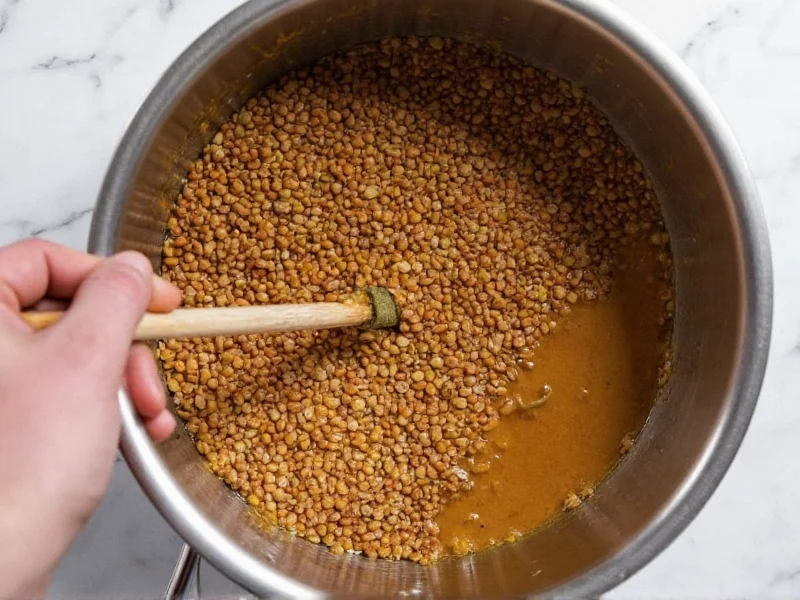The fastest way to cook lentils on the stove is to rinse 1 cup of lentils, combine with 2–3 cups of water or broth in a saucepan, bring to a boil, then reduce heat and simmer uncovered for 15–45 minutes (depending on variety) until tender but not mushy. No pre-soaking is required for most lentils, making them one of the quickest legumes to prepare.
Mastering stovetop lentil cooking unlocks a world of nutritious, protein-packed meals with minimal effort. Unlike other legumes, lentils don't require pre-soaking, making them perfect for weeknight dinners. This guide covers everything from selecting the right lentil variety to avoiding common cooking pitfalls, ensuring perfectly textured results every time you cook lentils on the stove.
Understanding Lentil Varieties for Stovetop Cooking
Not all lentils behave the same when cooking lentils on the stove. Choosing the right variety prevents mushy disasters or unpleasantly firm results:
| Lentil Type | Color | Cooking Time | Best Uses |
|---|---|---|---|
| Green/Brown Lentils | Olive green/tan | 20-25 minutes | Soups, stews, salads (hold shape well) |
| French Green (Puy) | Dark green with mottled skin | 25-30 minutes | Salads, side dishes (peppery flavor) |
| Red/Yellow Lentils | Orange to golden yellow | 15-20 minutes | Dals, purees, thick soups (mash easily) |
| Black (Beluga) | Jet black | 25-30 minutes | Caviar substitute, salads (shiny appearance) |
Essential Preparation Steps Before Cooking Lentils
Proper preparation ensures your stovetop lentil cooking experience yields perfect results:
- Sort carefully: Spread lentils on a light-colored surface to spot small stones or debris
- Rinse thoroughly: Use a fine-mesh strainer under cold running water until water runs clear
- Check for damaged lentils: Remove any discolored or shriveled pieces that may cook unevenly
- Measure accurately: Use the correct water-to-lentil ratio for your variety (see next section)
Perfect Water-to-Lentil Ratios for Stovetop Cooking
Getting the liquid ratio right prevents burning lentils on the stove or ending up with soupy results. These ratios work for 1 cup of dry lentils:
- Green/Brown Lentils: 2–2.5 cups liquid (yields firm texture for salads)
- Red/Yellow Lentils: 1.75–2 cups liquid (they break down more)
- French Green Lentils: 2.5 cups liquid (require slightly more water)
- Black Lentils: 2.25 cups liquid (cook to al dente perfection)
Add salt only after lentils have softened slightly (about 10 minutes into cooking). Adding salt too early can toughen lentils and extend cooking time significantly when boiling lentils on the stove.
Step-by-Step Guide to Cooking Lentils on the Stove
Follow these precise steps for foolproof lentil cooking on stove results every time:
- Sort and rinse 1 cup lentils as described above
- Combine lentils with appropriate amount of cold water or broth in a 2–3 quart saucepan
- Add aromatics like 1 smashed garlic clove, 1 bay leaf, or 1/2 onion (optional but recommended)
- Bring to a rapid boil over high heat, stirring occasionally
- Once boiling, reduce heat to maintain a gentle simmer (small bubbles breaking surface)
- Cover partially with lid, leaving 1-inch gap for steam to escape
- Simmer until tender but still holding shape, checking texture starting at 15 minutes
- Drain any excess liquid immediately when done (lentils continue cooking off heat)
- Remove aromatics and season with salt, pepper, and acid (lemon juice or vinegar) to taste
Avoiding Common Stovetop Lentil Cooking Mistakes
Even experienced cooks make these errors when preparing lentils on stove:
- Adding acidic ingredients too early: Tomatoes, vinegar, or lemon juice added at the beginning can prevent lentils from softening properly. Wait until the end of cooking.
- Overcrowding the pot: Cook no more than 2 cups dry lentils at a time for even cooking.
- Stirring too frequently: Excessive stirring breaks down lentils, especially red varieties. Stir only occasionally.
- Guessing doneness: Always taste test starting at minimum cooking time. Lentils should be tender with slight resistance.
- Leaving them in hot water: Drain immediately when done to prevent overcooking from residual heat.
Flavor Boosters for Perfect Stovetop Lentils
Elevate your lentils cooked on stove from basic to restaurant-quality with these professional techniques:
- Toast before cooking: Sauté rinsed lentils in olive oil for 2-3 minutes until fragrant before adding liquid
- Use flavorful liquid: Substitute water with vegetable broth, mushroom stock, or coconut milk for richer taste
- Add umami boosters: Include a strip of kombu seaweed or teaspoon of miso paste (dissolved in liquid)
- Finish with fresh herbs: Stir in chopped parsley, cilantro, or dill just before serving
- Acid balance: A splash of apple cider vinegar or lemon juice brightens flavors in cooked lentils
Storing and Reheating Cooked Lentils
Proper storage maintains texture when you cook lentils on stove in batches:
- Cool completely within 2 hours of cooking
- Store in airtight container with some cooking liquid (1/4 cup per cup lentils)
- Refrigerate for up to 5 days or freeze for 3 months
- Reheat gently in saucepan with splash of water to restore moisture
- Never microwave lentils without added liquid (they become rubbery)
Troubleshooting Your Stovetop Lentil Results
Fix common issues when making lentils on stove:
- Mushy lentils: Overcooked or used wrong variety. Next time reduce cooking time by 5 minutes and check texture earlier.
- Hard lentils: Old lentils or insufficient cooking time. Add 1/4 cup hot water and cook 5 more minutes.
- Burnt bottom: Heat too high or insufficient liquid. Use heavier pot and maintain gentle simmer.
- Uneven texture: Lentils weren't sorted properly. Always inspect before cooking.
- Bland flavor: Didn't season properly. Add salt in last 5 minutes of cooking for best results.











 浙公网安备
33010002000092号
浙公网安备
33010002000092号 浙B2-20120091-4
浙B2-20120091-4